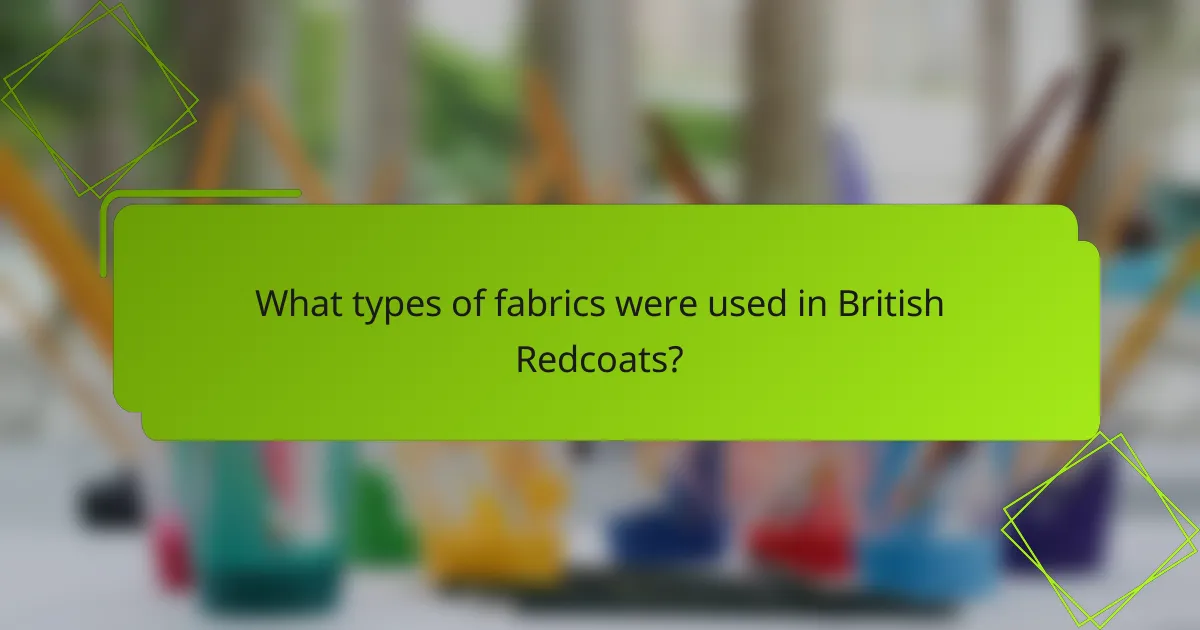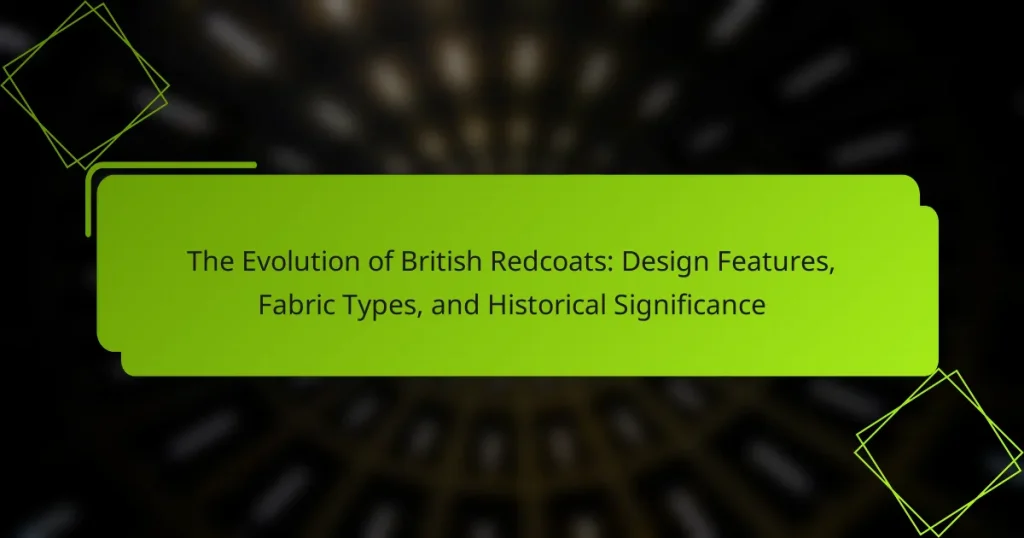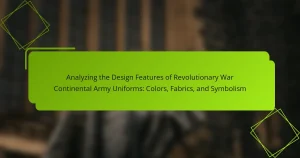British Redcoats were soldiers of the British Army, recognized for their iconic red uniforms, which symbolized military power and colonial authority during the 17th and 18th centuries, particularly in the context of the American Revolutionary War. The article explores the evolution of British Redcoats, detailing their distinctive design features, such as the fitted cut, epaulettes, and contrasting facings, which were standardized to enhance uniformity among troops. It also examines the materials used in their construction, primarily wool and cotton, chosen for their durability and functionality in various climates. Furthermore, the historical significance of the Redcoats is highlighted, showcasing their influence on military tactics and governance, as well as their lasting impact on modern military uniforms and cultural representations of British history.

What are British Redcoats and their significance in history?
British Redcoats were soldiers of the British Army, primarily known for their distinctive red uniforms. They gained prominence during the 17th and 18th centuries, particularly during the American Revolutionary War. The color red was chosen for its visibility and to intimidate opponents. Redcoats symbolized British military power and colonial expansion. Their presence marked significant battles, such as those at Lexington and Concord. The Redcoats also represented the British Empire’s authority over its colonies. Their historical significance lies in their role in shaping military tactics and colonial governance. The legacy of the Redcoats continues to influence modern military uniforms and cultural representations of British history.
How did the design of British Redcoats evolve over time?
The design of British Redcoats evolved significantly from the 17th century to the 19th century. Initially, Redcoats featured simple designs with minimal ornamentation. By the 18th century, the uniform became more standardized, emphasizing bright red wool fabric. The introduction of white facings and lace trim in the late 1700s added a distinctive flair. During the Napoleonic Wars, the design incorporated practical elements like epaulettes and shako hats. The use of lighter materials improved comfort and mobility for soldiers. By the 19th century, the design included various regimental distinctions, reflecting unit pride and identity. This evolution mirrored changes in military tactics and the need for functionality in combat.
What were the initial design features of British Redcoats?
The initial design features of British Redcoats included a bright red coat, which served as a distinctive uniform color. The coat was typically made from wool and featured a long cut that reached the knees. It often had white facings, which were contrasting colors on the cuffs and collar. The design included brass buttons, which added a decorative element. British Redcoats also wore a tricorn hat, which was a popular style during the 18th century. Additionally, the uniform was complemented by white trousers or breeches. These design elements were standardized for easier identification on the battlefield. The red color was chosen for its visibility and to symbolize the British military.
How did the design change during different historical periods?
The design of British Redcoats evolved significantly across historical periods. In the 17th century, the initial designs featured simple cut and bright red fabric. By the 18th century, the introduction of lace and embroidery added decorative elements. The late 18th century saw the adoption of more tailored fits, improving mobility. During the Napoleonic Wars, the design included epaulettes and shako hats for distinction. The Victorian era introduced more practical fabrics and streamlined designs. Each change reflected advancements in military strategy and technology. Historical records indicate that these design shifts were often influenced by the need for functionality and uniformity in the ranks.
What role did British Redcoats play in military conflicts?
British Redcoats served as the primary infantry of the British Army during military conflicts. They were known for their distinctive red uniforms, which became symbolic of British military power. Redcoats played crucial roles in various wars, including the American Revolutionary War and the Napoleonic Wars. They utilized linear tactics, forming tight ranks to maximize firepower. Their presence often bolstered British morale and demonstrated military discipline. The Redcoats were involved in significant battles, such as Bunker Hill and Waterloo. Their effectiveness in combat contributed to the expansion of British influence globally. The legacy of the Redcoats continues to be recognized in military history.
How were British Redcoats perceived by their contemporaries?
British Redcoats were perceived with a mix of admiration and resentment by their contemporaries. Many viewed them as symbols of British military power and discipline. Their bright red uniforms were designed to be distinctive and intimidating on the battlefield. However, they also faced criticism for their role in colonial conflicts. American colonists often regarded them as oppressors during the Revolutionary War. This dual perception was shaped by their actions in various conflicts. For instance, the Boston Massacre in 1770 intensified negative sentiments towards them. Conversely, some British citizens admired their bravery and commitment. Overall, the perception of British Redcoats varied significantly based on geographical and political contexts.
What impact did British Redcoats have on warfare tactics?
British Redcoats significantly influenced warfare tactics during the 18th and early 19th centuries. Their distinctive uniforms and disciplined formations changed the perception of military engagement. The Redcoats utilized linear tactics, where soldiers fired in unison to maximize firepower. This approach increased battlefield efficiency and effectiveness. Additionally, the Redcoats’ emphasis on discipline and training improved coordination among troops. Their strategies also included the use of flanking maneuvers, which disrupted enemy formations. The introduction of light infantry units added flexibility to traditional tactics. Overall, British Redcoats set new standards for military organization and combat strategy.
What cultural significance do British Redcoats hold today?
British Redcoats symbolize historical military heritage in Britain today. They represent the British Army’s role in shaping national identity. The iconic red uniform is associated with British colonial history and military prowess. Redcoats are often featured in historical reenactments and ceremonies. They evoke a sense of nostalgia for the British Empire and its global influence. Additionally, Redcoats are a popular subject in art and literature, reflecting their cultural impact. Museums often showcase them to educate the public about military history. Overall, British Redcoats continue to hold significant cultural value as symbols of tradition and heritage.
How are British Redcoats represented in modern media?
British Redcoats are often depicted in modern media as symbols of British military history. They are frequently shown in films and television series set during the 18th century. This portrayal emphasizes their distinctive red uniforms and disciplined formations. Historical dramas often focus on their role in the American Revolutionary War. Video games also feature Redcoats, showcasing their tactics and uniforms. Documentaries provide insight into their historical significance and evolution. This representation highlights both their military prowess and cultural impact. Overall, modern media presents British Redcoats as iconic figures of British heritage.
Why are British Redcoats considered iconic symbols of British history?
British Redcoats are considered iconic symbols of British history due to their prominent role in the British Army during the 17th to 19th centuries. Their distinctive red uniforms became synonymous with British military power and colonial expansion. The term “Redcoat” itself evokes images of British soldiers in major conflicts, including the American Revolutionary War. The visual impact of the bright red fabric made soldiers easily recognizable on the battlefield. This uniform style reflected both military tradition and national identity. Redcoats represented British authority and were instrumental in establishing the British Empire. Their legacy continues to influence cultural representations of British history today.

What are the key design features of British Redcoats?
The key design features of British Redcoats include a distinctive red woolen fabric, a fitted cut, and functional elements like epaulettes. The red color served as a symbol of British military identity. The fitted cut allowed for ease of movement during combat. Epaulettes were used to denote rank and unit affiliation. Additionally, the coats often featured white or buff facings, which provided contrast. The design also included functional pockets for carrying small items. These features were standardized in the 18th century to create a uniform appearance among soldiers. The overall design was both practical and symbolic, reinforcing the British military’s presence on the battlefield.
How did color and insignia contribute to the identity of British Redcoats?
Color and insignia significantly contributed to the identity of British Redcoats. The bright red color symbolized British military power and unity. It made the soldiers easily recognizable on the battlefield. The uniform’s distinctive color created a sense of cohesion among troops. Insignia represented rank and regiment, providing clear identification. This helped in maintaining order during chaotic combat situations. The use of color and insignia also instilled pride and loyalty among the soldiers. Historical records indicate that the red coat became a symbol of British imperial strength by the 18th century.
What colors were commonly used in British Redcoat uniforms?
British Redcoat uniforms primarily featured red as the dominant color. Red was chosen for its visibility on the battlefield. Additionally, white was commonly used for facings and cuffs. Other colors included blue and black for various regiments. The use of red dates back to the 17th century. This color helped distinguish British troops from their enemies. The design evolved over time, but red remained a consistent feature. Historical records confirm these color choices were standard in British military attire.
How did insignia and embellishments signify rank and regiment?
Insignia and embellishments signified rank and regiment through distinct visual markers. These markers included badges, colors, and embroidery specific to each unit. For example, officers often wore more elaborate insignia than enlisted soldiers. Different colors represented various regiments, allowing for quick identification on the battlefield. The use of epaulettes indicated rank, with more decorations denoting higher positions. Historical records show that these visual cues were crucial for maintaining order in military formations. During the 18th century, the British Army standardized these insignia to enhance uniformity and clarity. This system of insignia and embellishments was instrumental in fostering unit pride and cohesion.
What practical features were included in the design of British Redcoats?
British Redcoats featured several practical design elements. The wool fabric provided insulation and durability. The bright red color aided in visibility during battle. The cut of the coat allowed for ease of movement. The design included a high collar to protect against the elements. Buttons were placed for secure fastening and quick removal. Pockets were incorporated for carrying small items. The length of the coat offered protection from the weather. These features combined to enhance functionality in military operations.
How did tailoring and fit affect the functionality of Redcoats?
Tailoring and fit significantly impacted the functionality of Redcoats. Well-tailored uniforms allowed for ease of movement during combat. Proper fit ensured that soldiers could perform physical tasks without restriction. Tailored designs also facilitated quick access to weapons and gear. The use of high-quality materials contributed to durability and comfort. Historical records show that poorly fitted uniforms led to issues in mobility and effectiveness. For instance, during the American Revolutionary War, fit became crucial for soldiers’ performance. Overall, tailoring and fit directly influenced the operational efficiency of Redcoats in various military engagements.
What materials were used for the construction of British Redcoats?
British Redcoats were primarily constructed from wool. Wool was chosen for its durability and warmth. The fabric was often dyed red, resulting in the iconic color associated with British soldiers. Additionally, linen was used for lining and undergarments. Leather was also incorporated for belts and accessories. These materials provided both functionality and a distinct appearance. Historical records confirm the use of these fabrics in military uniforms during the 18th and 19th centuries.

What types of fabrics were used in British Redcoats?
British Redcoats were primarily made from wool and cotton fabrics. Wool was favored for its durability and warmth, suitable for various climates. This fabric provided insulation and was often used for the outer coats. Cotton was also used, especially for lining and lighter garments. The use of these fabrics was essential for functionality in military uniforms. Historical records indicate that the iconic red color was achieved through specific dyeing processes on these materials. The combination of wool and cotton allowed for both comfort and practicality in the field.
What were the primary fabric types used for British Redcoats?
The primary fabric types used for British Redcoats were wool and linen. Wool was favored for its durability and warmth. It provided essential protection in various weather conditions. Linen was used for lighter garments and underlayers. The combination of these fabrics allowed for both comfort and practicality. Historical records indicate that wool was the predominant choice during the 18th century. This choice was influenced by the need for resilience in military uniforms.
How did wool and cotton differ in their use for Redcoats?
Wool and cotton served different purposes for the Redcoats. Wool was primarily used for its durability and warmth. It provided insulation in various weather conditions. Wool also had natural water-resistant properties. This made it suitable for military uniforms. In contrast, cotton was lighter and more breathable. It was often used in warmer climates. Cotton uniforms allowed for better mobility. However, cotton lacked the insulation and durability of wool. Historical records show that wool was favored for winter campaigns. Cotton was more common in summer uniforms.
What innovations in fabric technology influenced Redcoat production?
Innovations in fabric technology that influenced Redcoat production include the development of wool blends and dyeing techniques. The introduction of lighter, durable wool blends improved comfort and mobility for soldiers. Advances in dyeing allowed for more vibrant and consistent red colors. These innovations ensured that Redcoats stood out on the battlefield. The use of serge, a tightly woven wool fabric, provided durability and weather resistance. Additionally, the adoption of cotton blends made uniforms more breathable. These fabric advancements contributed to the effectiveness and functionality of the Redcoat uniform.
How did fabric choice impact the performance of British Redcoats?
Fabric choice significantly impacted the performance of British Redcoats by influencing their mobility, comfort, and protection. The primary fabric used was wool, which provided insulation and durability. Wool allowed soldiers to maintain body heat in cold conditions. However, it also absorbed moisture, which could lead to discomfort during prolonged rain. The bright red dye used in the fabric was intended for visibility on the battlefield. This choice, while providing a psychological advantage, also made them targets. Additionally, the weight of the fabric affected soldiers’ endurance during long marches. Heavier fabrics could lead to fatigue, while lighter options improved agility. Historical records indicate that these fabric characteristics shaped tactical decisions in various campaigns.
What role did weather conditions play in fabric selection?
Weather conditions significantly influenced fabric selection for British Redcoats. Cold and wet weather necessitated the use of wool, known for its insulation and water-resistant properties. Wool could keep soldiers warm and dry during harsh conditions. In contrast, warmer climates required lighter fabrics like cotton or linen. These materials allowed for breathability and comfort in heat. Historical records indicate that the British Army adapted fabric types based on seasonal weather patterns. This adaptability ensured that soldiers remained effective in various environments.
How did fabric durability affect the longevity of Redcoat uniforms?
Fabric durability significantly influenced the longevity of Redcoat uniforms. High-quality materials, such as wool and cotton, were commonly used. These fabrics provided resistance to wear and tear during combat. Durable fabrics also offered protection against weather conditions. The longevity of uniforms was crucial for maintaining a soldier’s appearance and morale. Historical records indicate that well-maintained uniforms lasted through multiple campaigns. This extended lifespan reduced the need for frequent replacements. Consequently, durable fabrics contributed to operational efficiency and cost-effectiveness for the British Army.
What are the best practices for preserving historical British Redcoats?
The best practices for preserving historical British Redcoats include controlled environmental conditions, proper storage, and careful handling. Maintaining a stable temperature and humidity level is crucial. Ideal conditions are typically around 65-70°F and 40-50% humidity. Storing Redcoats in acid-free materials prevents degradation. Using padded hangers or archival boxes protects the fabric from stress and light exposure. Regular inspections help identify any signs of deterioration early. Cleaning should be done with care, preferably by a textile conservator. These methods are supported by conservation standards established by institutions like the American Institute for Conservation.
The main entity of this article is the British Redcoats, soldiers of the British Army known for their distinctive red uniforms. The article explores the evolution of British Redcoat design from the 17th to the 19th centuries, detailing key attributes such as fabric types, tailoring, and insignia that contributed to their identity and functionality. It examines their historical significance in military conflicts, their impact on warfare tactics, and their cultural representation in modern media. Additionally, the article addresses the practical features of Redcoat uniforms, the role of weather conditions in fabric selection, and best practices for preserving these historical garments.




